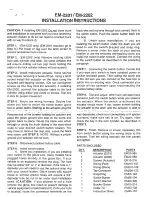
2003 VOLVO XC90
pg. 95 Starting and driving
Brake system
BRAKE Brake circuit malfunction
The brake system is a hydraulic system consisting of two master cylinders and two separate brake
circuits. If a problem should occur in one of these circuits, it is still possible to stop the vehicle with the
other brake circuit.
If the brake pedal must be depressed farther than normal and requires greater foot pressure, the stopping
distance will be longer.
A warning light in the instrument panel will light up to warn the driver that a fault has occurred.
If this light comes on while driving or braking, stop immediately and check the brake fluid level in the
reservoir.
NOTE: Press the brake pedal hard and maintain pressure on the pedal - do not pump the brakes.
WARNING!
If the fluid level is below the MIN mark in the reservoir or if a "Brake failure - Service urgent"
message is displayed in the text window: DO NOT DRIVE. Have the vehicle towed to a Volvo
retailer and have the brake system inspected.
NOTE: When the vehicle is at a standstill and the engine is idling, e.g. at a traffic light and the brake
pedal is depressed, the pedal may go down slightly. This is a normal function of the power-assisted
brake system.
Power brakes function only when the engine is running
The power brakes utilize vacuum pressure which is only created when the engine is running. Never let
the vehicle roll to a stop with the engine switched off.
If the power brakes are not working, the brake pedal must be pressed approximately four times harder
than usual to make up for the lack of power assistance. This can happen for example when towing your
vehicle or if the engine is switched off when the vehicle is rolling. The brake pedal feels harder than
usual.
Water on brake discs and brake pads affects braking
file:///K|/ownersdocs/2003/2003_XC90/03xc90_06b.htm (1 of 17)12/30/2006 4:18:59 PM
















































